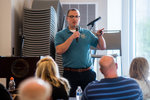





Seven months clean and sober, Kalina Goodwin took the stage before more than 100 local leaders and residents Wednesday and detailed the depths to which her two-decade battle with opioid addiction had taken her.
“I was a homeless drug addict living under bridges,” she said. “I felt shunned by the community. … We are good people, but addiction takes control. I needed help.”
For Goodwin, that help came in the form of the Drug Court program, which provides addicts with substance treatment, community support, education and employment opportunities.
“Thanks to Drug Court and the 12-step program, my life has been saved,” she said. “Drug Court gave me the structure. Getting released from jail, every time I went back to the streets. The Drug Court program provided housing and a structure and a plan for me.”
Goodwin’s story was part of a community opioid forum, held Wednesday evening at Centralia College. Attendees heard from those on the front lines of the epidemic that has killed more than 700,000 Americans since 1999. Members of law enforcement, social workers, medical professionals and faith leaders spoke about their experience with the issue — outlining both the terrifying scope of the problem and the success stories they’ve had in their efforts to combat opioid addiction.
From all in attendance, ranging from public servants, elected leaders and people in recovery, the message was clear — this is everyone’s problem, victims deserve help and it will take a coordinated community effort to address the problem.
“The first thing they need is to know that somebody cares for them. We can’t treat people as lesser value because they’re struggling with addiction,” said Cole Meckle, pastor of Gather Church. “It’s hard stuff to deal with people at their worst, but they’re still people, and they have feelings and they have lives. We have to do something, and doing nothing isn’t an option.This problem isn’t going to go away if we just ignore it.”
Time and again, leaders asked the community to realize that those suffering from addiction are not people who sought out a dangerous lifestyle. Many were exposed to opioids through prescription medication.
“Almost a quarter of individuals who are prescribed opioids for chronic pain are misusing their medication,” said Katie Strozyk, community health service and contracts coordinator with Lewis County’s Public Health and Social Services Department. “It’s a misconception that this epidemic is all illicit drugs.”
Strozyk helped lead the event, asking questions to a five-member panel that included Goodwin, Meckle, Centralia Police Department Sgt. John Dorff, Dr. Benjamin May with Chehalis Family Medicine and Corrections Chief Chris Sweet with the Lewis County Sheriff’s Office. Many other community leaders spoke up during the public comment portion of the event.
The scope of the opioid epidemic, Strozyk said, is vast. It’s killing 700 people annually in Washington state, with 1,600 people hospitalized statewide in 2017. In Lewis County, there were 82 emergency department visits related to opioids last year, with more than 1,000 people completing a substance use disorder assessment in order to seek treatment.
While Lewis County’s death rates are somewhat lower, Strozyk said the crisis is having huge system impacts, taking children away from families, taking people out of the workforce, burdening law enforcement, courts and the healthcare system.
EMS responders in the county are administering naloxone — which can block the effects of an opioid overdose in progress — 75 to 100 times a year. Naloxone, also known as narcan, was a major topic of discussion. According to Dorff, local law enforcement agencies have used it 15 times since they began carrying it in recent years, with 14 of those times being successful. Dorff himself has saved three lives with it.
“I do know that it works. I’ve seen it firsthand three times,” he said. “There’s lot of people in the community that are like, ‘These people do this to themselves. Why is it our job to help them?’ Well, that’s what we signed up for. We signed up to save lives. Sometimes it’s unfortunate we have to save people from themselves.”
Meckle said Gather Church is also distributing narcan kits to any community member who wants to be prepared if they come across an overdose. He offered to distribute more of them to attendees following the event.
Meanwhile, Sweet talked about efforts who treat those who find themselves incarcerated. Recently, the jail began a medication-assisted treatment program, offering medication and treatment to fight withdrawals not only while an inmate is incarcerated, but providing them with continued treatment options after their release.
“Our goal is they don’t go back to using. Our goal is for them to continue that treatment,” Sweet said. “Hopefully we don’t see them again in our jail.”
Leaders acknowledged that the community response has not always been favorable, with social media comments bemoaning that taxpayer resources are being used to help those who have broken the law. But they asked residents to show more compassion, and to realize that working to restore people into society will ultimately benefit everyone.
“It isn’t understood by anyone around them,” May said. “Their loved ones don’t understand, their friends don’t understand. … I’ve never met a single addicted person who wants to be addicted. A lot of people don’t understand what that struggle is and that it’s not their choice to be addicted.”
Kevin Dickey, the county’s drug court compliance officer, spoke up and made an emotional appeal of his own.
“Every person in this place right now deserves a shot,” he said. “Those people would do anything not to be addicted now. … The jail is a window of opportunity. They may not be able to do it on the street. They may not be able to stay clean long enough to go get help. If they’re doing it in the jail, and they have the opportunity to get started, they might make it.”
Sweet echoed that sentiment.
“I’ve had questions, ‘Why are you giving them drugs in jail? Why are you doing this?’” he said. “That’s my response, you haven’t seen these individuals that want to be saved.”
Many have been saved, panelists said, showing the importance of continued investment.
“There are people in this room who I have known at their worst,” Meckle said. “If you’re not one of them, I can almost guarantee you would not be able to pick them out.”
Along with Goodwin, a pair of other individuals in recovery spoke up, thanking the agencies and groups that helped them restore their lives. Many other families and residents looked on attentively, no doubt including some who have seen opioid addiction firsthand.
Going forward, leaders acknowledged the opioid crisis will be a continued challenge. Sweet and Meckle cited the lack of low-cost housing in the county, as many people who are released from jail or just need help simply have nowhere to stay. Meckle said the church is working to establish a women’s shelter, another community need.
“It is crazy the number of people I encounter who truly have no place to go,” he said. “We need to find ways in our community to help lower some of those barriers, In a culture that values profit, this is going to cost us something.”
Barriers to treatment and counseling can also be a challenge. Many of the groups represented said it’s difficult to find people help promptly. In response, a representative from Cascade Mental Health said her organization actually has the capacity to see patients quickly, and hoped to spread community awareness so that people in need can be directed there. Meckle noted that even the opportunity for treatment isn’t always enough, as people suffering from addiction often have trouble making appointments, which can lead to them getting dropped from Medicaid.
“It is easy to find opioids, and it’s hard to find treatment,” May said. “It’s getting more providers and counseling services involved, and making it a multifaceted approach to finding those who are in need and getting them set up with something that works for them. … It’s making everything more achievable and attainable, so that people who want treatment can get it and people who are struggling can get help. We always need to remember, when one person’s life is saved, that’s a life that’s saved. It needs to be celebrated and advertised.”
JP Anderson, deputy director at the county’s Public Health department, highlighted the work of the Morton UP Coalition and the Centralia Coalition, which are working on the prevention side of the issue, asking “how do we prevent the next generation of opioid users?” Additionally, the Lewis County Opioid Task Force, a fairly new group that helped organize the Wednesday event, is working on its strategic plan for the future, which will incorporate much of the feedback from the forum.
County commissioner Edna Fund said she was disappointed that only a handful of other elected officials had shown up for the otherwise well-attended event, and encouraged those with an interest in the issue to show up to city council meetings and make their concerns known. County sheriff Rob Snaza said he intended to “shame” other law enforcement agencies that don’t yet carry narcan, part of his goal to make the county a statewide leader on opioid issues.
“Why not us? Why do we have to be followers?” he said. “This county, we are doing things that nobody else is doing because of the partnerships we have. … We’re going to continue and be the leaders in making a difference in people’s lives.”
That urgency, displayed by all in attendance, is crucial, Strozyk said. The opioid crisis is expected to rage on for at least another decade, possibly longer if there’s not an all-hands-on-deck effort to address it.
“Historically as communities, we’ve been looking at it as preventing a house from catching on fire,” she said. “We’re at the point of the epidemic where we have to look at it as if the house is already on fire. … We need to address the fire itself at this point, otherwise we’re never going to get ahead.”